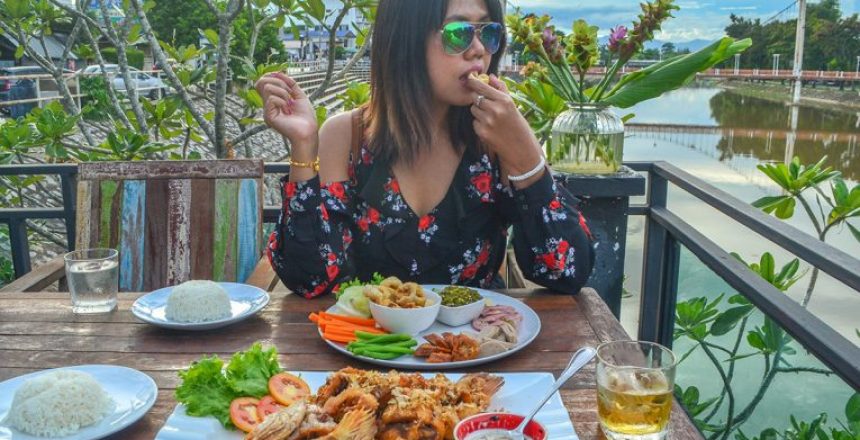Northern Thai Food (Lanna food) is a unique food set which presides in the Northern regions of Thailand. Foods which originated from the ancient Kingdom of Lanna (hence Lanna food) and many which are hard to find in other regions of Thailand. Traditionally eating in Northern Thailand is haunched at small, round tables known as Khantoke tables (pictured below) and if given the chance do not pass on a Khantoke feast. Here you will find Northern Thai food at its best. Note that Northern Thai food is not the same as Northeastern Thai food (Isan Food). While Isan food can be found in Northern Thailand it is very different to the foods of Lanna. Here are my Top 10 Northern Thai food (Lanna Food). Two of the better cities to find Lanna food in include Chiang Mai and Chiang Rai.

1. Khao Soi Curry (Khao Soi, ข้าวซอย)
Khao Soi Curry is easily the most popular dish with visitors to Northern Thai Food. For me it also the most underrated of curries in Thailand. Khao Soi should top everyone’s ‘to do’ list when eating Thai Food. A mild, coconut based curry served over soft egg noodles and topped with crisp egg noodles. Perfected by optional additions of lime, onion, chilli and pickled cabbage. Khao Soi is easily found in both street food and restaurants throughout Northern Thailand and costs around 30 to 50 baht per bowl. You will also find Khao Soi on many Bangkok menus.
2. Northern Thai Sausage (Sai Oua, ไส้อั่ว)
Or ‘Chiang Mai Sausage’ as it is often known. This tasty, spiced pork sausage is found everywhere in the North and is not to be missed. While hard to admit it even beats my beloved Isan Sausage. It is honestly that good. Sai Oua fuses many of the signature Thai tastes; the sour of lemongrass and kaffir lime leaves, the heat of chillies and of course the all important kick from galangal (ginger). Prepared in spiral lengths and sold at most street sides and local markets of Northern Thailand. It is also a big favourite at the Khantoke Table. For those who can’t get enough Northern Thai Sausage it is also found uncooked to fly home with (as we do). Costs roughly 300 Baht per Kilo.
3. Chilli Dips (Nam Prik Ong น้ำพริกอ่อง / Nam Prik Noom
น้ำพริกหนุ่ม)
Both the above are popular Northern Thai chilli sauces; both essential eating at every Khantoke table. ‘Nam Prik Ong’ is the more popular of dips a blend of red, birds-eye chillies with pork and tomato. My preferred dipping sauce however is the ‘Nam Prik Noom’ a fiery dip combining flavours of toasted green chilli, onion and garlic. If no feasts planned during your visit you can still find these dips on restaurant menus matched with nibbles of Kap Moo (deep fried pork skins), sticky rice and a selection of vegetables.
4. Northern Pork Curry (Kaeng Hang Lei, แกงฮังเล)
A tender, stewed pork curry which reminds me of the generic microwave ‘curries’ of the UK (if that means anything to you). The sauce of Kaeng Hang Lei is the least spicy of curries I’ve come across in Thailand and is slightly fruity with tastes of tomato. Of course 100% delicious and makes the perfect curry for those with a less fiery palate. Kaeng Hang Lei brings a slight Burmese influence infusing turmeric with tamarind, ginger and garlic. While popularity doesn’t quite match the Khao Soi curry it does rank highly on Northern Thai menus. Another favourite at Khantoke feasts.
5. Leaf Wrapped Bites (Miang Kham, เมี่ยงคำ)
Miang Kham is essential nibble food and offers the perfect introduction to Northern Thai Food and essential Thai flavours. With Miang Kham you can pick and mix your own combination of sweet, sour, salty and hot flavours. Wrap ingredients in a Cha Plu leaf and pop in your mouth. While ingredients vary with Miang Kham they do normally include a similar set of shallot onion, chillies, ginger, peanut, coconut and lime bits. While occasionally found on restaurant menus the Khantoke table is the better option. Also available pre-wrapped or sold as sets in local markets.
6. Fermented Pork Sausage (Naem, แหนม)
A minced pork and sticky rice sausage with a unique sour taste from a 2 day fermentation process. Flavoured with garlic and chilli this meaty treat is not so different to the better-known Isan sausage from nearby North East regions. It is also one of the few Northern Foods common to Bangkok streets often found sizzling and skewered over hot charcoals at city street food vendors. While Naem can be eaten raw I would stick with the cooked option.
7. Northern Noodles (Khanom Jeen Nam Ngiao, ขนมจีนน้ำเงี้ยว)
‘Khanom Jeen’ – fresh rice noodles and ‘Nam Ngiao’ – spicy tomato-infused broth. Bring together for a uniquely Northern Thai noodle soup. While there are heartier options of this dish; traditional preparation uses minced pork balls and generous chunks of jellified pigs blood, mixed with rices noodles and served in a thin, tomato and spice infused pork broth. Only made better by additions of lime, beansprouts, pickled cabbage and kap moo (deep fried pork skin).
8. Unripe Jackfruit Curry (Kaeng Khanun, แกงขนุน)
A Northern Thai equivalent to the better-known Tom Yum? Except not as delicious. The Kaeng Khanun is a hot and sour soup which infuses an added fruity flavouring of young unripe jackfruit and the Northern Thai favourite of cherry tomatoes. Often served with welcome chunks of pork. I won’t say my Kaeng Khanun is my least favourite of Northern Thai foods but given the above options, it comes low in the pecking order.
9. Steamed Pork Salad (Yum Moo Yor, ยำหมูยอ)
A boiled pork sausage with white complexion and rubbery texture. Moo Yor is one of the most common Northern Thai Foods and is therefore in need of a mention. Alone Moo Yor doesn’t really compete with the spice of Sai Oua or sour of Naem and because of this I have made a meal of it. The meal is Yum Moo Yor which fuses the Yum Moo steamed pork with a fiery salad of chillies, fish sauce, lime and coriander. A common dish in restaurants of Northern Thailand. For Moo Yor meat you can easily find it at roadside shops, wrapped in green banana leaf and stacked in pyramids. Costs roughly 30 Baht a packet. Feel free to eat whole like a giant, meat sausage. (Note Moo Yor is also popular in Isan food and is famous in Ubon Ratchathani)
10. Booze (Maa Kratoop Rong, ม้ากระทืบโรง)
As always… drink the local liquors. On my recent trip the drink of choice was Maa Kratoop Rong which was the name of the added herb ingredients in the locally produced moonshine rice liquor (pictured below). Very similar to a Yaa Dong mix of Lao Khao. Potent alcohol mixed with ‘health enhancing’ plants and herbs. Today’s tipple said to give power, alertness and most importantly acts as a strong aphrodisiac. Like liquid viagra although I can’t say it worked. Again the best place to these local concoctions is at Kantoke feasts served alongside nibbles and Traditional Thai dancing.





